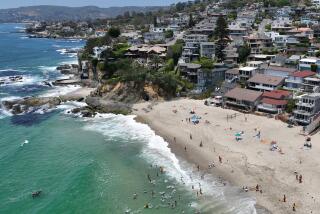Ocean’s Free, Parking Won’t Be : State to Charge for Use of Trestles Lot, to the Dismay of Surfers
- Share via
Many of Orange County’s hard-core surfers call Trestles beach the finest stretch on the West Coast for its rugged beauty and the supreme freedom of the waves.
Over the decades, they’ve also savored the freedom to park their cars nearby without having to pay.
But that will change at the last park-for-free beach in Orange County as the state plans to install a park-yourself machine at the 100-car lot north of the beach, which straddles Orange and San Diego counties.
Although it’s unclear exactly when the machine will be installed, preparatory work has begun, and surfers and surf watchers who face having to feed the machine up to $4 a day for parking are already declaring the news a bummer.
“It’s a sad thing,” said Doug Craig, a 72-year-old surfer from Dana Point who has ridden the waves here since 1938. “The state is taxing the people again for pleasure. (Surfers) work here and pay taxes and pay extra to go to the beach.”
State Chief Ranger Mike Tope said the parking fees are a tiny part of the state’s large-scale effort to raise funds as the recession continues to batter the budget.
The state Parks and Recreation Department began installing parking devices at all its beaches, including Bolsa Chica, Huntington, Doheny, Crystal Cove, San Clemente and San Onofre, after being told in 1990 to boost revenue.
The department has received a permit from the Coastal Commission to put a park-yourself machine at the lot north of Trestles. Although minor construction has started on the project, further action hasn’t been taken yet because no appropriation for the machine is included in the state’s current fiscal budget.
“The last fiscal year was very tight, and there isn’t any funding available,” Tope said. But parks officials say it’s only a matter of a little more time before Trestles goes the way of the other formerly free state beaches.
When installed, the parking machine is expected to raise about about $80,000 a year for the state.
Local surfers are outraged, claiming that parking fees collected at state beaches are put into building roads and other community structures rather than back into the parks and recreation budget.
“The parks department doesn’t use fees for the beach, they go into the general fund,” said Tex Haines, co-founder of the Laguna Beach Surfrider’s Assn. “We’re being taxed hard. (The state) was putting money toward the parks and that was acceptable, but now it goes to building roads and other things. It’s now tea tax time, one more case of taxation without representation.”
“I think the beaches should be free,” added Doheny Long Boarders Assn. President Gene Eudaly.
But Tope said Haines is wrong, and that parking fees will go into the state parks and recreation budget and be used to maintain beach lots, including garbage removal and striping projects.
Plans to charge for parking at Trestles also concerns San Clemente city officials, who fear that beach-goers will avoid paying for parking by leaving their vehicles on El Camino Real or the neighboring side streets.
“The paid parking will have a negative impact on the neighborhood,” said Bruce Wegner, the city’s director of parks and recreation. However, Wegner believes the state will work with San Clemente to offset parking congestion in residential areas.
Work has begun to install a cement pad for the park-yourself machine near Trestles while parks officials discuss when the machine itself will be brought in.
Carl Drake, manager of aquatic programs for the state, said, “We are mandated by state law to charge fees wherever feasible” and that Trestles has been identified as a recreational area where parking fees will be charged.
Named for the two railroad track trestles across San Mateo Creek, Trestles was originally part of the Santa Margarita Ranch in the 1930s. The land was purchased by the military during World War II and used as a training area for the Marine Corps.
It remained government property until 1972, when the late former First Lady Pat Nixon lobbied to release the land to the public. The beach is near the home used as a Western White House by then-President Richard Nixon and Mrs. Nixon.
More to Read
Sign up for Essential California
The most important California stories and recommendations in your inbox every morning.
You may occasionally receive promotional content from the Los Angeles Times.










